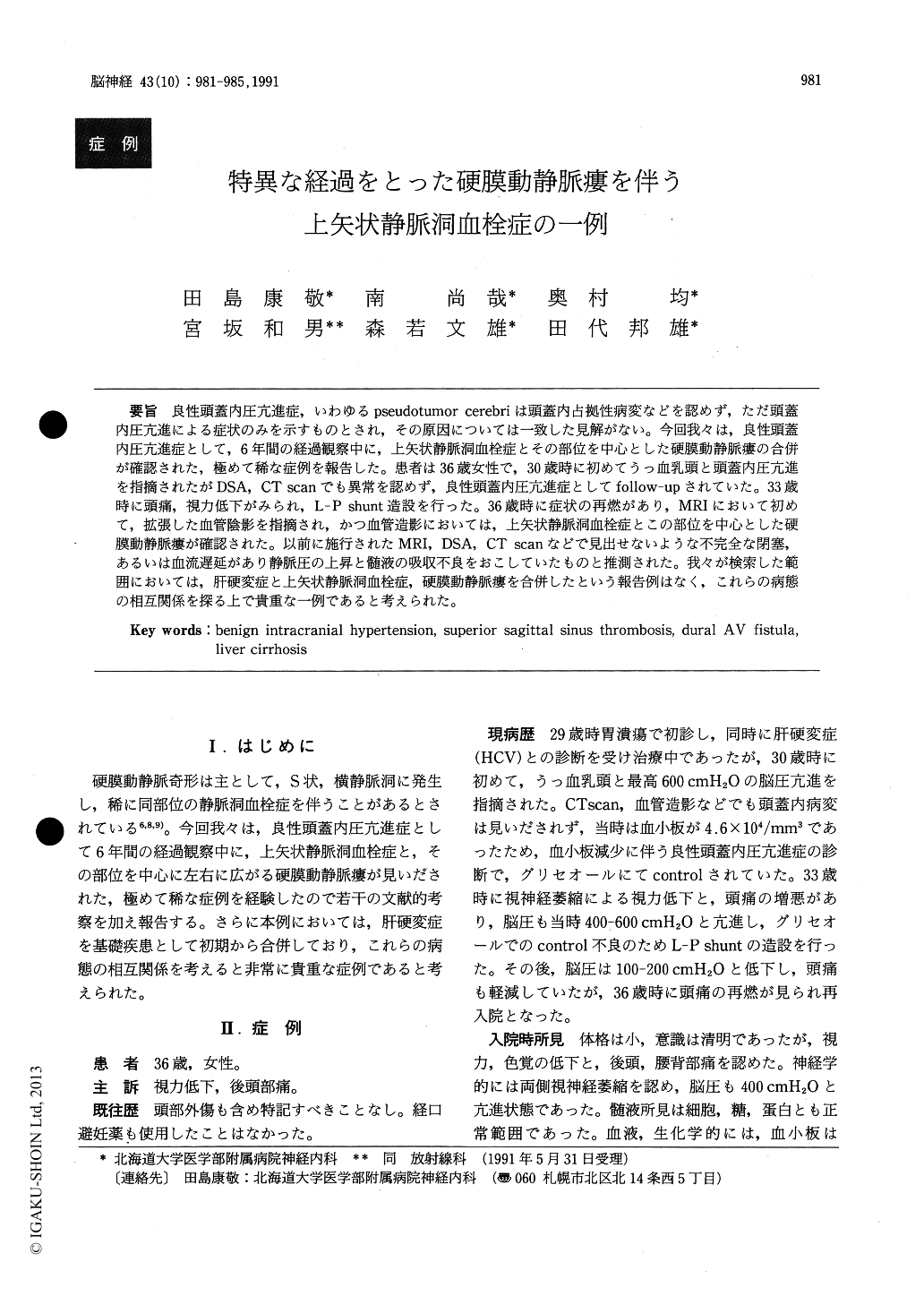Japanese
English
- 有料閲覧
- Abstract 文献概要
- 1ページ目 Look Inside
良性頭蓋内圧亢進症,いわゆるpseudotumor cerebriは頭蓋内占拠性病変などを認めず,ただ頭蓋内圧亢進による症状のみを示すものとされ,その原因については一致した見解がない。今回我々は,良性頭蓋内圧亢進症として,6年間の経過観察中に,上矢状静脈洞血栓症とその部位を中心とした硬膜動静脈瘻の合併が確認された,極めて稀な症例を報告した。患者は36歳女性で,30歳時に初めてうっ血乳頭と頭蓋内圧亢進を指摘されたがDSA,CT scanでも異常を認めず,良性頭蓋内圧亢進症としてfollow-upされていた。33歳時に頭痛,視力低下がみられ,L-P shunt造設を行った。36歳時に症状の再燃があり,MRIにおいて初めて,拡張した血管陰影を指摘され,かつ血管造影においては,上矢状静脈洞血栓症とこの部位を中心とした硬膜動静脈瘻が確認された。以前に施行されたMRI, DSA, CT scanなどで見出せないような不完全な閉塞,あるいは血流遅延があり静脈圧の上昇と髄液の吸収不良をおこしていたものと推測された。我々が検索した範囲においては,肝硬変症と上矢状静脈洞血栓症,硬膜動静脈瘻を合併したという報告例はなく,これらの病態の相互関係を探る上で貴重な一例であると考えられた。
Benign intracranial hypertension or pseudotumor cerebri is an collective term for a number of diverse syndromes characterized by increased intracranial pressure. Neither intracranial mass nor ventriculardilatation is observed in this disorder. Moreover, the pathogenesis of this syndrome has yet to be deter-mined. We report a case of 36-year-old female diagnosed as benign intracranial hypertension, who has developed superior sagittal sinus thrombosis and dural AV fistula during the follow up period. The patient was pointed out to have papilledema and elevated intracranial pressure six years ago. Although she was examined by both DSA and CT scan, no abnormal intracranial lesions were obser-ved. Consequently, she was diagnosed as the benign intracranial hypertension and had been followed as an out patient. Three years later, lumboperitoneal shunting was performed because of severe headache and visual impairment. Postoperatively, the patient had been well for two years. Recently, occipital headache recurred and she was readmitted to our hospital. MRI studies demonstrated dilated vessels in the right occipital area. Additionally, angiograms revealed not only the superior sagittal sinus throm-bosis but also the rich network of dural AV fistula adjacent to the occulsion. According to those results, the superior sagittal sinus was supposed to have the incomplete occulsion or delayed blood flow that were not observed by DSA, MRI and CT scan performed previously. Those occulsive change in the superior sagittal sinus impeded the CSF absorp-tion and elevated the pressure of venous inflow, then the arterio - venous communication has been deve-loped. Intriguingly, developement of collateral chan-nel was likely to lower the venous pressure so that the patient had no clinical manifestations induced by intracranial pressure elevation, three weeks after the admission. On the other hand, the patient has been known to have liver cirrhosis since she was 29 years old. There have been no previous reports of liver cirrhosis accompanied with sinus thrombosis and dural AV fistula. This case should shed some light on identifying pathogenesis of these disorders.

Copyright © 1991, Igaku-Shoin Ltd. All rights reserved.


